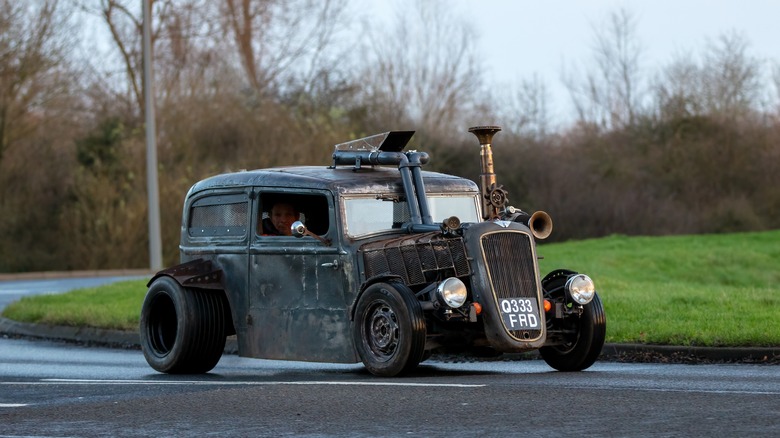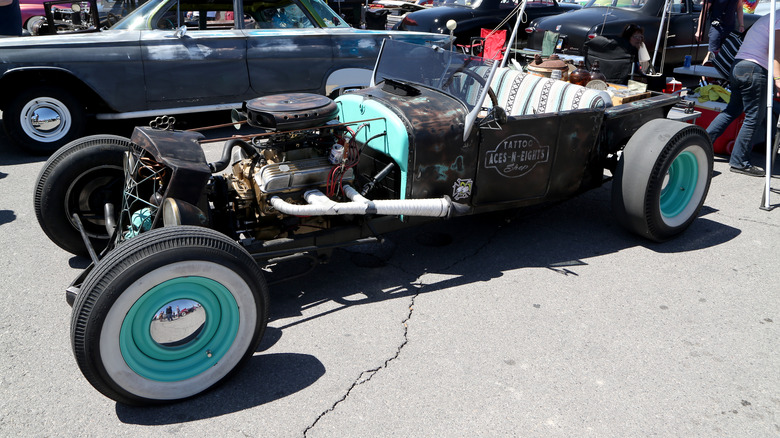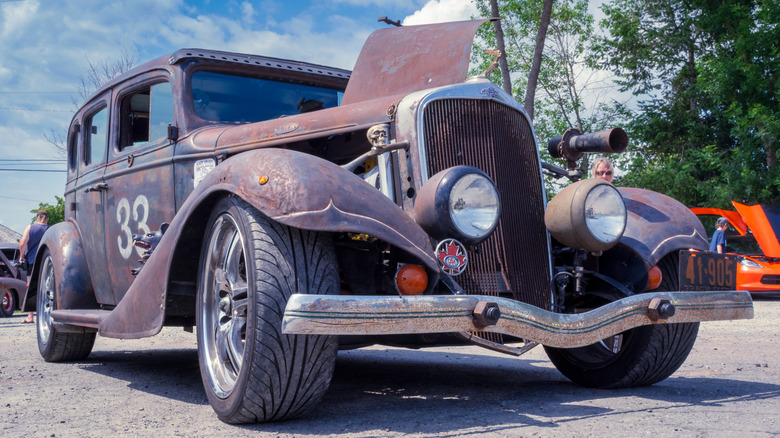What Is A Rat Rod, And How Is It Different From A Hot Rod?
Anyone who is at least passingly familiar with custom cars has probably at least heard of the concept of a hot rod. A hot rod is, of course, a custom car designed with the express purpose of going as fast as realistically possible. Technically, any car, modern or retro, can be modified into a hot rod, though the traditional image of a hot rod is of an older car like a Ford Model T that's been souped up with a massive protruding engine.
It'd be fair to assume that anyone who owns a hot rod would go out of their way to keep it in immaculate condition, especially if it was built out of an older car. It may seem a bit paradoxical, then, to see a hot rod rolling down the street with a rust-covered hood or jury-rigged parts. It is possible that the hot rod owner just let their vehicle go a bit, but the far more likely answer is that what you're seeing isn't a hot rod at all. What you're seeing is the hot rod's rebellious younger sibling, the rat rod.
The origin of the rat rod
The original practice of hot rod customization can be traced as far back as the 1920s, with gear-minded teenagers digging old Model Ts out of their parent's garages and replacing the components with souped-up successors. The practice was very open-ended at first, with builders slotting in whatever engines, transmissions, and other parts they could get their hands on. Around the 1950s, hot rodding became more mainstream, with homebrew car clubs getting gearheads together to create the fastest, sleekest rides imaginable and hitting the racetracks.
However, as the decades rolled on, there was a bit of discontent in some hot rodders, who were unsatisfied with the growing emphasis on sleek, neat exteriors created through extensive financial investment from car clubs. After all, if you wanted to drive something sleek, neat, and expensive, you could drive a car off the lot. This is why, in the '80s and '90s, a certain subset of hot rodders began emphasizing the homebrew look more with rusty, unfinished exteriors. Thus, the rat rod was born.
The term "rat rod" is believed to have been coined by Hot Rod Magazine Editor Gary Baskerville, who used it to refer to a junked-up hot rod owned by artist Robert Williams.
What makes a rat rod?
The makeup of a rat rod, unlike in a hot rod, is less about its driving capability and more about its style. To create a rat rod out of a hot rod, you need to inflict deliberate, controlled damage upon it with the ultimate goal of creating something rugged and lived-in. It's kind of like acid-washing jeans.
The simplest thing you can do to start the rat rod look is to just remove nonessential components from the car's surface. For example, you can remove panels from the engine housing or strip paint from the doors, exposing some raw metal and a smidgen of rust. To take it further, you can add large, exaggerated wheels and exhaust pipes, like something out of an Ed Roth drawing.
If you're really going for that homebrew garage look, you can replace entire components of the car with jury-rigged items, like wrenches instead of door handles or a kitchen whisk instead of a gear shifter. It doesn't matter if it's unsafe or even works properly — the point is to look cool.
The name of the game here is to make your hot rod look as rugged as possible without hampering its ability to scream down the road. Creating this particular grungy garage aesthetic adds artistic punctuation to a hot rod that makes it look like you salvaged the entire thing from an old scrap heap and Frankensteined it together.


